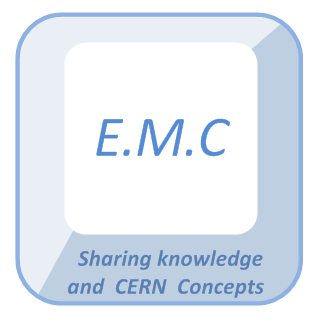A switch-mode converter principle is based on noise generator cells, which must be reduced & kept in the converter.
Remenber that the best and safer way to reduce EMC noise created by a converter is to switch it off.
Very high level of precision obtained for CERN power converters certainly relies on their low EMC noise management.
Different sources of noices exist: magnetic field (switching cells = dI/dt), and electrical field (components = dV/dt)

Main source of noises of a power converter .vsd
A standard dysimetrical measurement (ground to active signal) collect both differential and common mode noises, both coming from different paths and excitations.
- Differential mode noise is generally in the low frequency range < 1MHz, and comes from the power components acting as noise sources while taking power from network (harmonics on non sinusoidal current). A switching capacitor delivering square current will generate a voltage ripple amplified by its series parasitic inductance and resistor.
- Common mode noise is generally in the high frequency range > 1MHz, and comes from component being excited versus chassis equipement, through their "body" to chassis or ground capacitance. A water cooled switching transistor will generate common mode current inside water cooled plate (chassis) through its drain capacitance to chassis (thermal conduction looked for generally magnifies it), being switched between +V and -V abruptly. This noise is generally amplified by some common mode path L series C of both low values, resonating at high frequencies.






 Both Noises
Both Noises
-
Both Noises
Both Noises
-
 Diff. Mode Noise Path
Diff. Mode Noise Path
-
Diff. Mode Noise Path
Diff. Mode Noise Path
-
 Common Mode Noise Path
Common Mode Noise Path
Common Mode Noise Path
Common Mode Noise Path
Typical LISN measurement with Spectrum Analyser and noise paths highlighted .xls
Common mode and Differential mode impact are very different.
- Differential mode represents a current which will use the conducting power lines, and the returning path is including in the noisy lines (power lines). A classical effect is the ripple of a converter, which can be locally and easily filtered with adequate filtering (capacitors). This differential noise can be present, without affecting all other signals, as long as they are not reffered (connected in a way) to it.
- Common mode represents a current which will use earth returning path. This is clearly the problem, since if noise coming lines is known (all power lines together), the return path is not clearly known and strongly depends on the equipement design, and the connection of its common bonding network to earth. This returning path will always include the equipment earthing connexion path, resulting in the equipement common bonding network to be excited versus earth. All the active electronic signals exchanged with other systems not being part of the equipement common bonding network, even if connected to earth will have to handle - reject - this potentially perturbing noise. Moreover, and along the different paths, medium quality cabling and grounding can transfer a part of this noise into differential noise, affecting directly the signal integrity. Since the common mode noise is very often in high frequency range (higher than 1 MHz), any even short connexion to earth will be excited by the common mode earth.
- Common mode current is sometimes called "antenna current". When a differential current will flow generally close to its return current, and then cancelling the radiation induced (always keep the area of a go-return cable the smallest as possible), the 2 "same direction" common current creates a radiation in the area being delimited by both them and the return path (ground) which can be quite big depending on the installation.
Converter Mode: Only Auxiliary Power Supplies ON (Voltage source control + Digital Control (FGC) + Current Sensors(DCCT))

Converter Mode: Half Bridge Switching Inverter

Converter Mode: Half Bridge Switching Inverter

Converter Mode: Full Bridge Switching Inverter

Converter Mode: Full Bridge Switching Inverter

Converter Mode: Full Bridge Switching Inverter

 OFF State
OFF State
-
OFF State
OFF State
-
 0A 0V
0A 0V
-
0A 0V
0A 0V
-
 100A 6V
100A 6V
-
100A 6V
100A 6V
-
 200A 12V
200A 12V
-
200A 12V
200A 12V
-
 450A 27V
450A 27V
-
450A 27V
450A 27V
-
 600A 37V
600A 37V
600A 37V
600A 37V

 |
|
 |
|
 |
CERN
|
SY
|
SY-EPC
|
EDMS
|
PROJECTS
|
ODF
/
OOXML
|
|
CERN
|
SY
|
SY-EPC
|
EDMS
|
PROJECTS
|
ODF
/
OOXML
|














